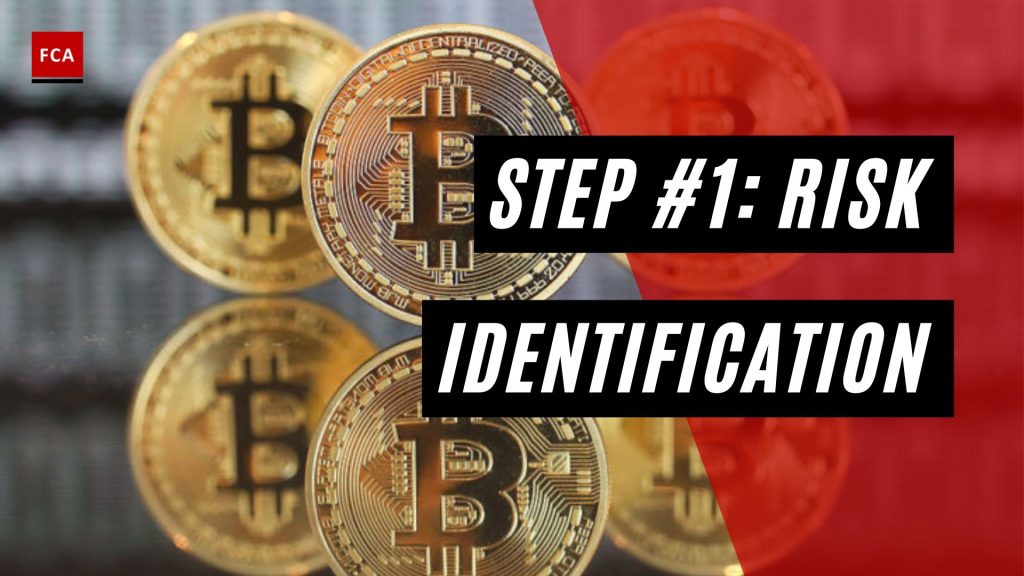Risk identification plays a pivotal role in effectively managing the risks associated with investing in cryptocurrencies. It encompasses the crucial task of identifying and evaluating all potential risks, leaving no stone unturned. The primary objective of this initial step is to ensure comprehensive risk identification, where no potential risk goes unnoticed or underestimated.
Step #1: Risk Identification
To achieve thorough risk identification, a systematic approach is imperative, involving a meticulous analysis of factors that can impact the value of cryptocurrencies.
Several key factors deserve careful consideration during the risk identification process:
- Market Volatility: Cryptocurrencies are notorious for their high volatility, with prices capable of fluctuating dramatically within a short period. Investors must factor in the potential impact of market volatility on their portfolio’s value.
Illustratively, in May 2021, Bitcoin’s value plummeted by almost 50% in a matter of weeks due to a combination of factors, including regulatory concerns in China and negative tweets from Tesla CEO Elon Musk.

- Liquidity Risk: Cryptocurrencies often suffer from limited liquidity, resulting in insufficient buyers or sellers to facilitate smooth transactions. This scarcity can lead to significant price fluctuations, potentially affecting an investor’s portfolio value.
For instance, in December 2020, Ripple’s XRP token witnessed a staggering 40% decline in a single day following a lawsuit filed by the U.S. Securities and Exchange Commission (SEC), raising concerns about the token’s classification as a security.
- Cybersecurity Risk: Cryptocurrencies are highly vulnerable to cyberattacks, necessitating a thorough evaluation of the potential impact of security breaches on portfolio value.
An illustrative example is the January 2018 security breach suffered by the Japanese cryptocurrency exchange Coincheck, resulting in the loss of over $500 million worth of NEM tokens and a subsequent 10% drop in the token’s value.
- Regulatory Risk: The regulatory landscape surrounding cryptocurrencies is constantly evolving, and investors must stay informed about regulatory changes that can impact their portfolio value.
For instance, in September 2017, China’s announcement of a ban on initial coin offerings (ICOs) and cryptocurrency exchanges led to a nearly 30% decline in Bitcoin’s value.

- Operational Risk: Cryptocurrency exchanges and service providers face various operational risks, including system failures, human error, and fraud. Investors need to evaluate the potential impact of such risks on their portfolio value.
An illustrative case is the January 2019 security breach suffered by Cryptopia, a New Zealand-based cryptocurrency exchange, resulting in the loss of over $16 million worth of cryptocurrency.
To effectively identify these and other potential risks, financial institutions can leverage a range of tools such as risk checklists, risk registers, and risk workshops. These tools aid in ensuring comprehensive risk identification, leaving no room for oversight.
For instance, a risk register is a document that meticulously records all identified risks, their probability of occurrence, their potential impact on the organization, and the corresponding action plan to mitigate each risk. This document serves as a vital reference point for the organization’s risk management efforts.
Furthermore, a risk workshop, facilitated by an external consultant or an internal risk manager, fosters a collaborative environment where stakeholders from diverse areas of the organization come together to brainstorm and identify potential risks. The aim is to comprehensively identify as many potential risks as possible and analyze them in detail.
Risk identification stands as the foundational pillar of cryptocurrency risk management. By adopting a systematic approach and considering critical factors such as market volatility, liquidity risk, cybersecurity risk, regulatory risk, and operational risk, investors can proactively identify and mitigate potential risks associated with investing in cryptocurrencies.

Final Thoughts
Risk identification serves as the crucial first step in effectively managing the risks associated with investing in cryptocurrencies. By systematically analyzing factors such as market volatility, liquidity risk, cybersecurity risk, regulatory risk, and operational risk, investors can gain a comprehensive understanding of the potential hazards and vulnerabilities they may encounter.
Through the use of tools like risk checklists, risk registers, and risk workshops, financial institutions can ensure that no potential risk is overlooked or underestimated. These tools facilitate a meticulous and collaborative approach to risk identification, allowing stakeholders from different areas of the organization to contribute their expertise and insights.








